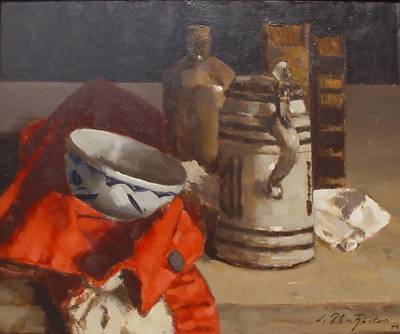
“Westerwald,” stoneware, OOC (oil on canvas) of a 1 liter stein, which is circa 1790.
STILL =
W.Mühlendyck mark called butterfly
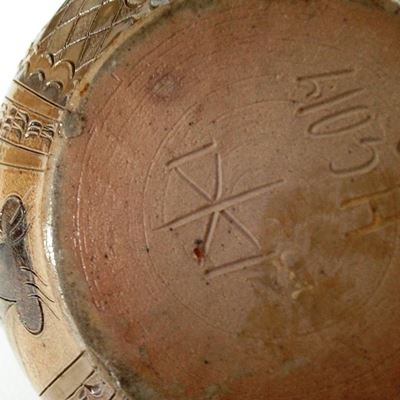
Wager cup – The word “cup” is the “misnomer” here, it is really a “game beaker” to be used in a pub or for home games with guests. They usually have dice in the bottom; and there are 100’s of different games to be played. Some modern pewter steins have the dice in the top. Shown: A wager cup done in “Old Sheffield Plate,” England, Ca. late 1700’s. [FWTD] There are 3 dice in the glass enclosed bottom. Also seen is a version with Irish coins made for that market.
Waidmann’s Heil – A hunters salutation equivalent to “Good Hunting.”
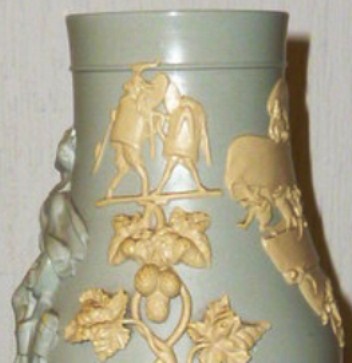
Walking steins in relief on a V & B Mettlach Server No. xxxx
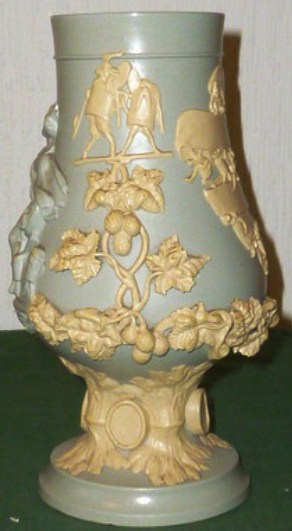
Walking steins – A motif found often on V &B Mettlach steins, perhaps designed by Schlitt. However there are walking steins shown on at least one scene on the early Westerwald mono – toned steins (The “Mud Steins.”)▼
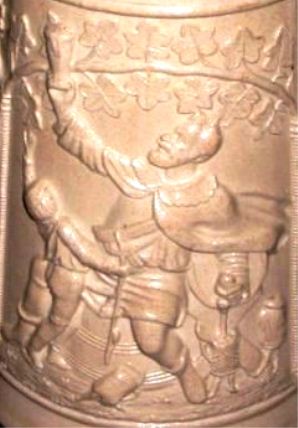
Detail of scene described below▼.
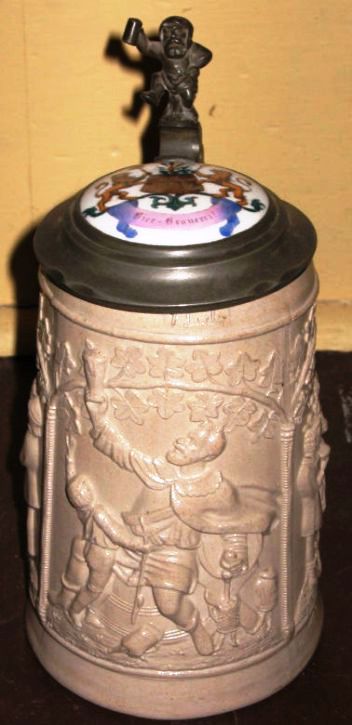
The scene shows Gambrinus holding up a pokal away from a young boy who wants it. Meanwhile “The King of Beers”*** is holding open a tap and a couple of steins are walking under it being filled up. (*** But not the Patron Saint of Beer = They are real Saints and there are many of them!
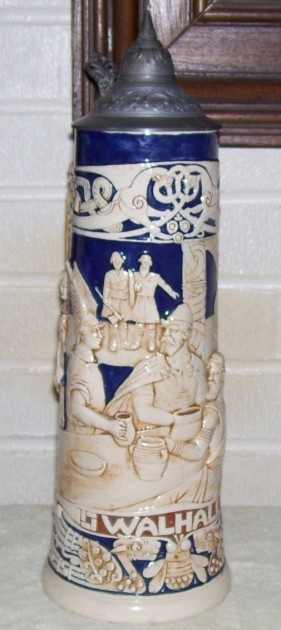
Walhalla (Germ.) – Valhalla (Eng.) [1]- NOTE: Walhalla is the German form of Old Norse Valhöll, which is commonly anglicized as Valhalla. Shown ▲ ▲: 2 liter pottery relief stein with scenes not seen very often with the Danish spelling= “Walhall.” This type of vine handle indicates it was made by J.W. Remi. [FWTD] Also see: Vikings” for the Gods represented on this piece. In old Norse mytholgy “Valhalla” (from the Old Norse: “hall of the slain”) is a majestic, enormous hall located in Asgard ruled over by the god Odin. Chosen by Odin, half of those who die in combat travel to Valhalla upon death, led by the Valkyries while the other half go to the goddess Freyja’s field called Fölkyangr. [2] In Germany, The Walhalla Memorial, The Hall of Fame, inaugurated 1842.
▼
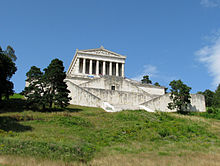
Walzenkrug (Germ.) – Straight sided jug or tankard, used primarily to describe the older non-production line, hand thrown pieces such as early fayence and stoneware steins. Shown: A late variant fayence stein, . 5liter. Circa 1810-40, with nice pewter “urn” thumblift. This type flat pewter lid is usually seen on glass steins of the same period.
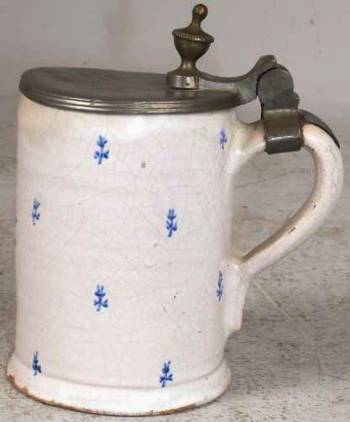
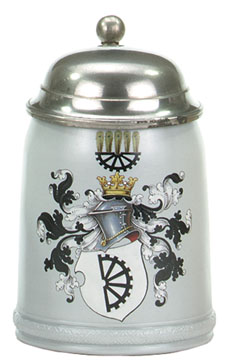 Wappen – The German for “Coat Of Arms.” [It is not a ‘crest’ Mr. Fox, or anyone else!] Shown: A hand enameled unknown “family wappen” on a 1 /2 liter V & B Mettlach body. [FWTD]
Wappen – The German for “Coat Of Arms.” [It is not a ‘crest’ Mr. Fox, or anyone else!] Shown: A hand enameled unknown “family wappen” on a 1 /2 liter V & B Mettlach body. [FWTD]
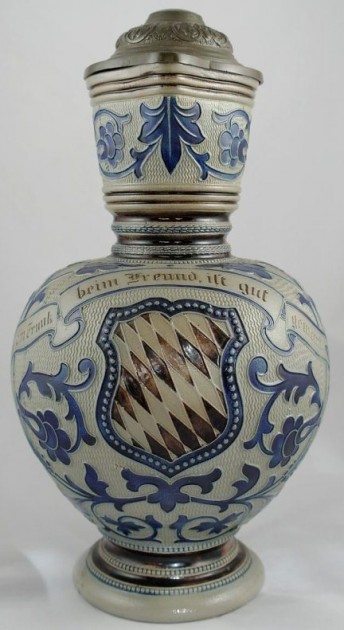 A Regensburg stoneware beer server with probably a family’s coat of arms (copied from some museum piece?) Very similar pattern to the Bavarian arms.
A Regensburg stoneware beer server with probably a family’s coat of arms (copied from some museum piece?) Very similar pattern to the Bavarian arms.
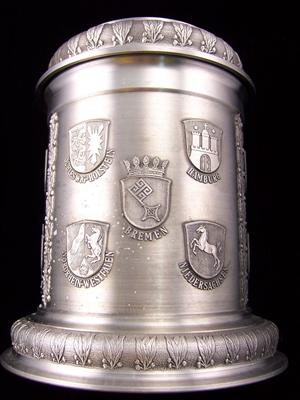
Wappenkrug – German for the steins that display two or more coat of arms, usually German cities close by each other or major metro areas. Shown above: “Brand New” pewter with the “Arms” (not Crests}) of the major cities of Germany.This make the stein saleable at many locations.
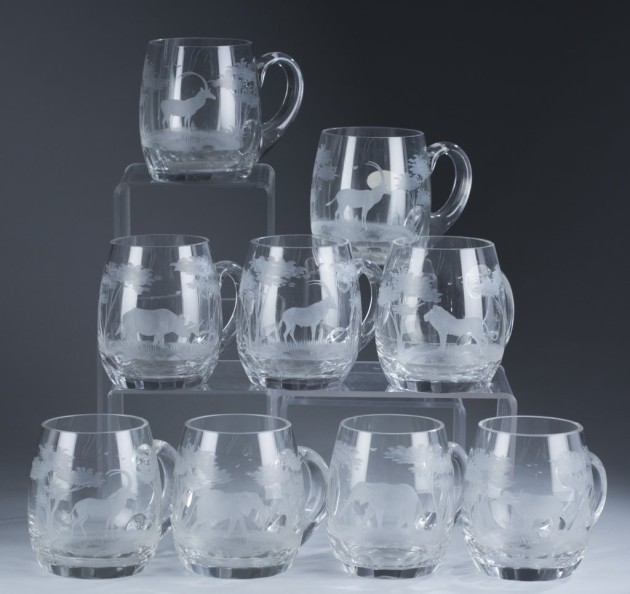
Ward, Rowland – maker of newer but well done German blown and engraved beer mugs.
Warrant Marks. – These special marks were used on Russian and English silver marks and indicated the selected Gold-smiths / Silver-smiths were used to make household objects and gifts for those Imperial Courts.
Warrant Mark, [above the name] Russian – The Russian silver-smith is Ovchinikov. See “Assay Mark” in this Compendium.
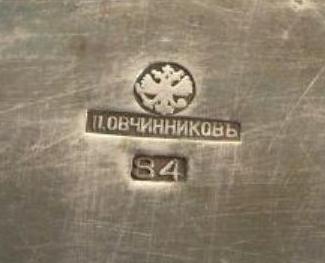
Warth, Christian – A prominent German artist who did designs for V & B Mettlach, such as above ▲ and below ▼.
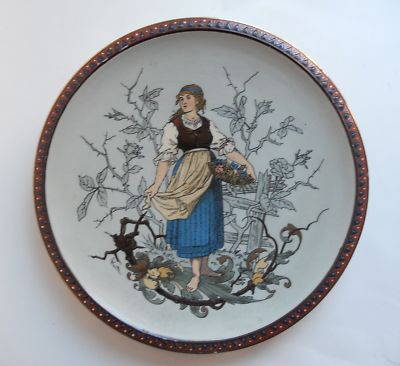
V & B wall plaque by Warth. – No. 1652 -1900 . His signature is on lower left at about 7:30 on a clock.
Warthog tusks – Used to decorate lots of drinking vessels and other items from Germanic countries, as below ▼.
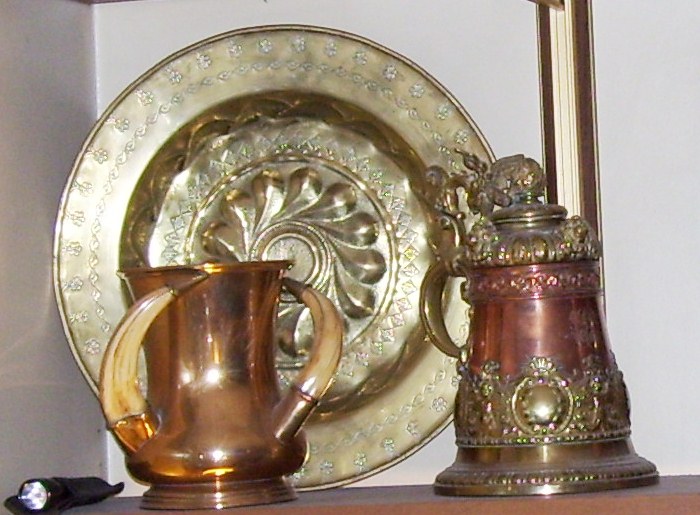
A large European copper three handled “Pass Cup” with Warthog tusks. [FWTD] For info on “Pass Cups” see: http://www.steveonsteins.com/pass-cups-a-short-history-new-12-26-10
WARWICK CO.; REF CHRIS – PUG OF MONK – 3 Warwick Art China IOGA, ALSO MONK PAGE
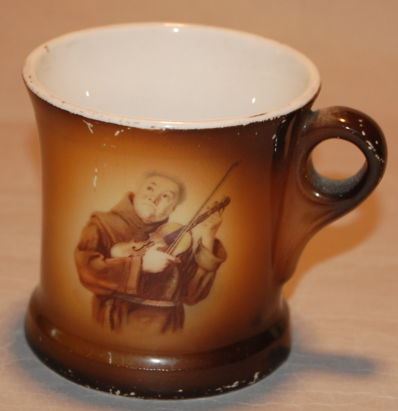
Wassail bowl / wassail cup- English Drinking vessels used for “wassailing” [see pot of it below] – usually found made of turned wood; the cups may or may not have a cover, lots of the older versions have lost them. Wassail (Old English wæs hæl, literally ‘be you healthy’) refers both to the salute ‘Waes Hail’ and to the drink of wassail, a hot mulled cider traditionally drunk as an integral part of “wassailing”, an ancient southern English drinking ritual intended to ensure a good cider apple harvest the following year. [From Wikipedia, the free encyclopedia:]
▼ Wassail bowl, turned English Oak C. 1750’s, 13 inches tall [FWTD] Found in downtown Denver Oct. 2013]

▼ WASSAIL BOWL SILVER MOUNTS ROBERT YOUNG ANTIQUES LONDON
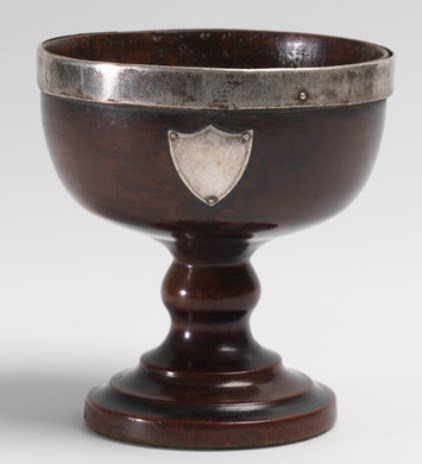
▼ Newer custom made “Wassail” bowl with medieval style grotesques engraved on the body made by a present day wood-smith in England. Wassail comes from the Old English words waes hael, which means “be well,” “be hale,” or “good health.” A strong, hot drink (usually a mixture of ale, honey, and spices) would be put in a large bowl, and the host would lift it and greet his companions with “waes hael,” to which they would reply “drinc hael,” which meant “drink and be well.” Over the centuries some non-alcoholic versions of wassail evolved.
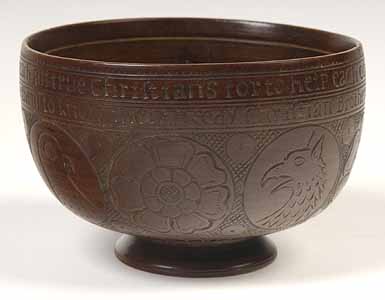
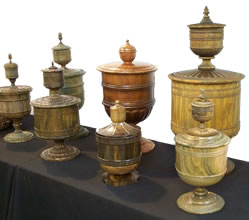
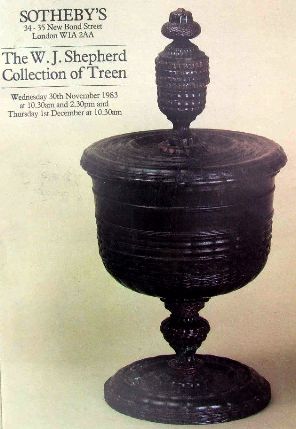
▼ A German-Austro equivalent to an English Wassail cup. Made in Switzerland most likely, it was called “Black Forest” on eBay in 2014, as most older Swiss wooden items are. [FWTD] (was not cheap)
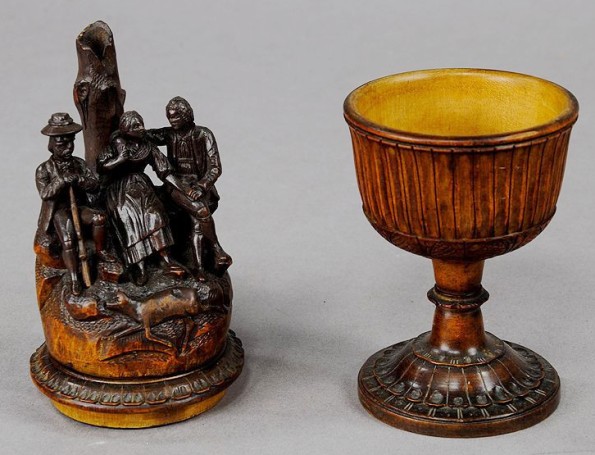
Watch on the Rhine – “Germania” on the river’s ledge awaiting to defend her Germany. Shown: Porcelain lid insert and early one as it has the double headed Imperial eagle on her shield, which changed to a single head in 1871.
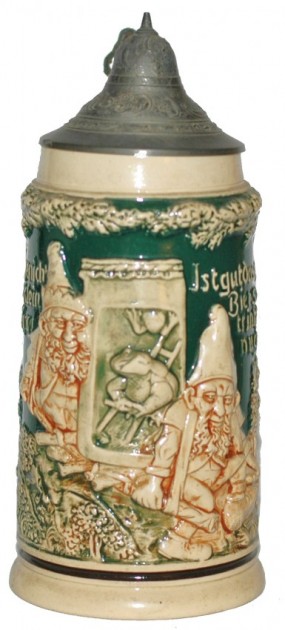 Weather frog – Shown ▲: .5 liter pottery of two gnomes carrying “the weather frog.” The higher he sits on the ladder in the bottle, the better will be the weather. For more on frog steins see: http://www.steveonsteins.com/froggie-went-a-bier-drinking-and-he-did-booze-a-huh-a-huh-with-apologies-to-frog-went-a-courtin-new-1-16-12
Weather frog – Shown ▲: .5 liter pottery of two gnomes carrying “the weather frog.” The higher he sits on the ladder in the bottle, the better will be the weather. For more on frog steins see: http://www.steveonsteins.com/froggie-went-a-bier-drinking-and-he-did-booze-a-huh-a-huh-with-apologies-to-frog-went-a-courtin-new-1-16-12
Webster-Wilcox Silver Plating Co. – Founded in 1865, with Jedediah and Horace Wilcox, Charles Parker, Aaron Collins, Hezekiah Miller as the primary partners, as the Wilcox Britannia Company in Meriden CT. The name was changed in 1867. It was later one of the founding companies of International Silver in 1898. The company plant was closed in 1941 due to the war metal shortage. After the war, its house designs were made by other International factories, but the company as a separate entity was not revived. In 1961, various divisions were consolidated and its name was changed to Webster-Wilcox. Shown: Copy of an American Revolutionarystyle tankard.(Paul Revere’s?) 8.5 inch tall. Done in silver plate. Unknown manufactured date, but after 1961. See: “Paul Revere tankard” also.
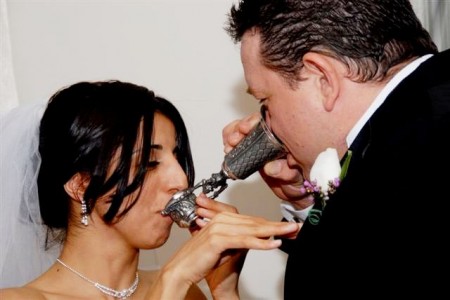 Wedding Cup (also called Marriage Cup and wrongly: Wager Cup) – Shown: The correct way to use this cup; featuring Mr. and Mrs. Michael Stephen Smith, April, 2008.
Wedding Cup (also called Marriage Cup and wrongly: Wager Cup) – Shown: The correct way to use this cup; featuring Mr. and Mrs. Michael Stephen Smith, April, 2008.
![Rsos - wedding cup on stamps HAVE IT POSTED [Q]](http://www.steveonsteins.com/wp-content/uploads/2013/06/Rsos-wedding-cup-on-stamps-HAVE-IT-POSTED-Q-630x285.jpg) ▲ Antique German .800 silver silver wedding cups.
▲ Antique German .800 silver silver wedding cups.
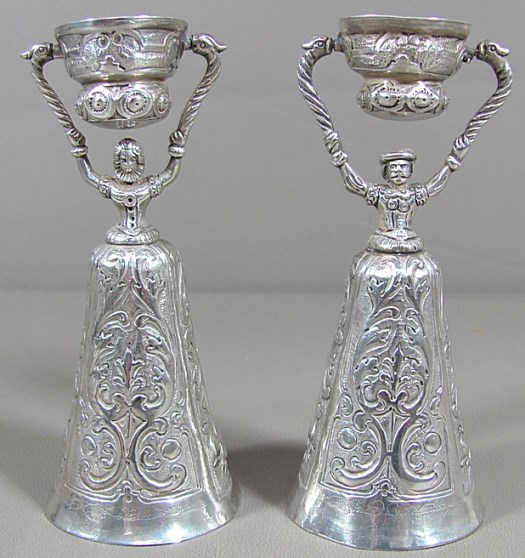
for more See: ‘Jungfraubechers’= Wedding cups; not wager cups!
@ http://www.steveonsteins.com/wedding-cupscups 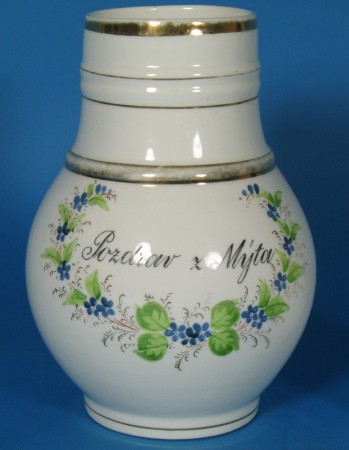 . Wedding jug (server) – Any jug or server that shows two names joined, two arms placed side by side, or of course one that says “For your wedding!” Shown: Austrian porcelain one liter jug with the wedding couple’s names painted on it.
. Wedding jug (server) – Any jug or server that shows two names joined, two arms placed side by side, or of course one that says “For your wedding!” Shown: Austrian porcelain one liter jug with the wedding couple’s names painted on it. 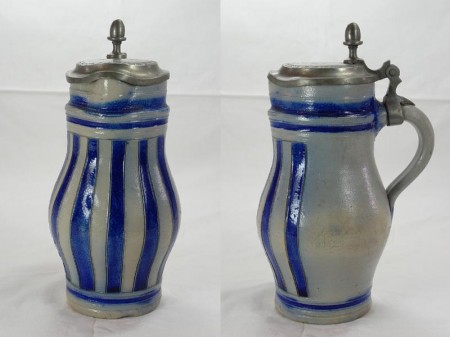 Weithalskrug (Germ.) – Wide necked jug. This style ▲is most often called a “Birnkrug” or “Birnkanne.” For more info, see: http://www.steveonsteins.com/some-of-the-beauties-of-the-westerwald-3
Weithalskrug (Germ.) – Wide necked jug. This style ▲is most often called a “Birnkrug” or “Birnkanne.” For more info, see: http://www.steveonsteins.com/some-of-the-beauties-of-the-westerwald-3 ![Mettlach stein, 1-32L, 2.5 ht., [Wekara], relief, Munich Child,](http://www.steveonsteins.com/wp-content/uploads/2013/01/Mettlach-stein-1-32L-2.5-ht.-Wekara-relief-Munich-Child-630x354.jpg)
Wekara – Made stein under contract for V & B Mettlach. This is a 1/32 Liter, 2.5″ ht., relief of the Munich Child. 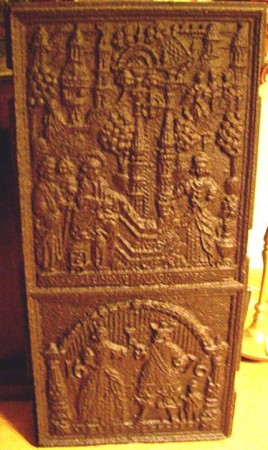
Welcome beaker or cup – A beaker used in European homes and fraternal society meetings to great a guest A custom from late medieval times, even to this day, as in: “Can I get you a Coke? iced tea?” The idea being to liquefy their friend’s parched throat and make them feel welcome into their new environment. Shown: Part of a 3 part Swiss cast iron fire back, dated 1663. On the bottom section is a “lovely” wife offering her husband a “welcome cup” upon his return home from wherever. [FWTD] Werkstatt Fischer in Bamberg – Makers of good quality Fayence steins around 1900. They look a lot like older ones from Schrezheim.
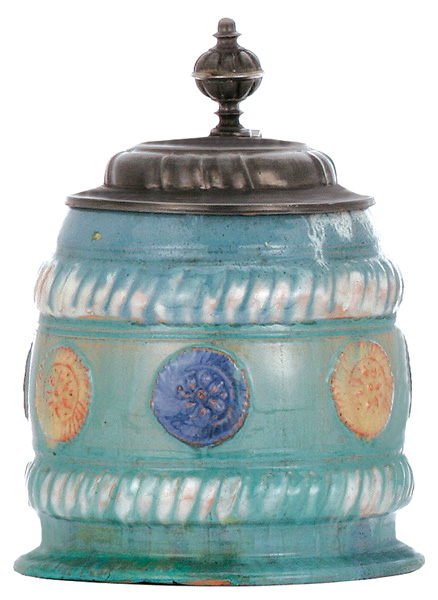 Werkstätten für Keramik Kunst, Munich – A small ceramic firm that made some very nice and some moderate newly designed copies of old lead-glazed steins mostly looking like Habnerware and not Majolica. Shown▲: .5 liter, their version of Habnerware. Circa 1920. For a full page article on this firm see: http://www.steveonsteins.com/majolica-english-type-or-lead-glazed-drinking-vessels-from-the-munchner-werkstatten-fur-keramische-kunst-the-munich-workshop-for-pottery-artwork
Werkstätten für Keramik Kunst, Munich – A small ceramic firm that made some very nice and some moderate newly designed copies of old lead-glazed steins mostly looking like Habnerware and not Majolica. Shown▲: .5 liter, their version of Habnerware. Circa 1920. For a full page article on this firm see: http://www.steveonsteins.com/majolica-english-type-or-lead-glazed-drinking-vessels-from-the-munchner-werkstatten-fur-keramische-kunst-the-munich-workshop-for-pottery-artwork
West Germany, Made in – “West Germany” was in existence from 1949 to 3 October 1990. Beer steins made then are considered “New” by SCI collectors. See: “Made in West Germany” on this site’s Compendium for much more info!!
Westerwald – A small area in the West of Germany in the Rheinland Pfalz, Germany, famous for its clay deposits and home to most of today’s stoneware and other ceramics beer stein manufacturers. Also called “Kannenbacker’s” land. Steins produced from this area in the 1700’s are called by the region’s name. This area has been producing stoneware drinking vessels for 100’s of years. Hohr-Grenzhausen is now the center city of the industry. Some of the history : Most of the ceramics of the places stated before (Siegburg, Cologne, Frechen and Raeren, etc.) have been subject to thorough research. The early period of the pottery activities in the south-west region of the Westerwald, however, did not find enough attention to attract personalities with a learned background to undertake thorough research into the early beginnings of the pottery in that part of the Rhineland. We know from documentary evidence that pottery was well established in 1402 already but no research into possibly excisting documents of the following times until the late fifteenhundreds has been carried out yet. However, we are in the possession of many hundreds of shards from various sites in the town of Hohr-Grenzhausen excavated and secured from construction sites in the second half of the past century by persons of the “Documentation Centre of the Kannenbackerland”. These finds are now scientifically examined with archaeological methods and also subjected to physical-chemical analysis by the Universtiy of Applied Science in Hohr-Grenzhausen. This project is sponsered and accompanied by the Documentation Centre supported by the Ceramics Museum Westerwald with the perspective to gain substantial knowledge of the early beginnings of the Westerwald Pottery and the further developement to the decorative Stoneware starting in the late 16th century. Shown below ▼: An old blue and gray 3 liter stoneware “Birnkrug” (PEAR JUG)) with incised decor. Circa
1840-50
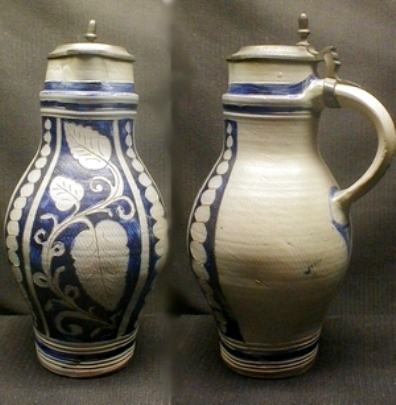 See a rather lengthily article about these jugs: http://www.steveonsteins.com/some-of-the-beauties-of-the-westerwald-3
See a rather lengthily article about these jugs: http://www.steveonsteins.com/some-of-the-beauties-of-the-westerwald-3 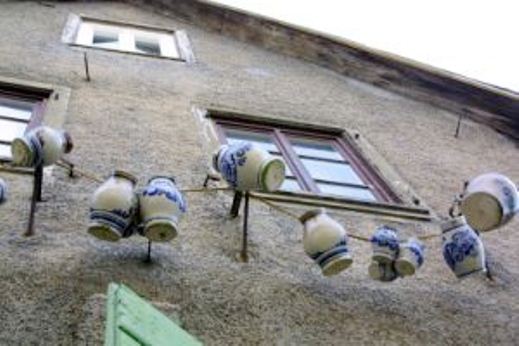 What I thought was an interesting way to display your company’s Westerwald stoneware pots and jugs! Hang them outside so every one can see what you make and know they are at the right building!Westerwald incised and patterned “Walzekrug” (straight sided) stein. Ca. 1820. See also: Saltglazed, stoneware, Regensberg steins, and Mud steins. For much more good info on German stoneware please see: http://www.thepatriotexchange.com/pss/wester.htm
What I thought was an interesting way to display your company’s Westerwald stoneware pots and jugs! Hang them outside so every one can see what you make and know they are at the right building!Westerwald incised and patterned “Walzekrug” (straight sided) stein. Ca. 1820. See also: Saltglazed, stoneware, Regensberg steins, and Mud steins. For much more good info on German stoneware please see: http://www.thepatriotexchange.com/pss/wester.htm 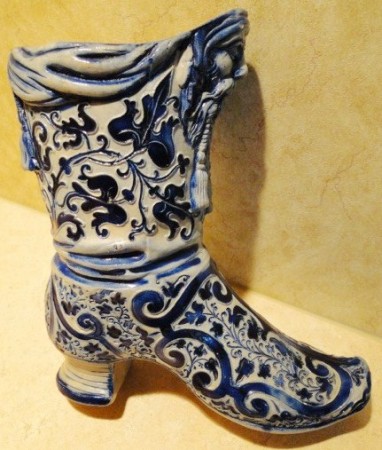 Shown: A Westerwald drinking boot. Ca 1885. For more info on “Drinking boots” see: http://www.steveonsteins.com/the-man-who-can-not-drink-his-boot-full-of-beer-is-not-a-true-bavarian-new-10-13-1
Shown: A Westerwald drinking boot. Ca 1885. For more info on “Drinking boots” see: http://www.steveonsteins.com/the-man-who-can-not-drink-his-boot-full-of-beer-is-not-a-true-bavarian-new-10-13-1 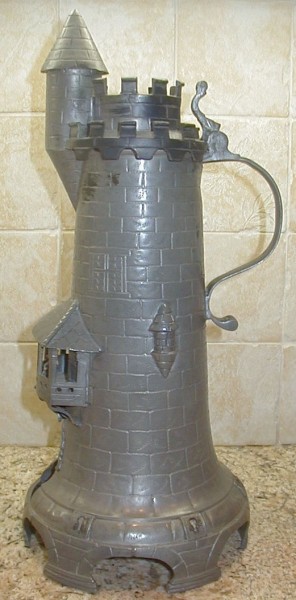
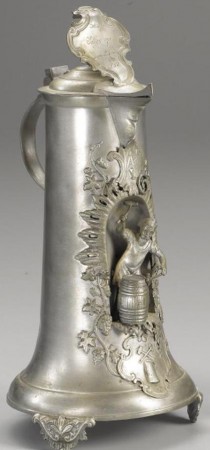 Weygang, A, and family – Well known pewter–smith family, famous for their pewter “tower” character steins and “niche tankards” (the misnomer here is when they are called “Guild Steins”) For more info on this maker, see: http://www.steveonsteins.com/future-4-the-famile-weygangs-steins-and-servers Also see: http://www.steinmarks.co.uk/pages/pv.asp?p=stein1
Weygang, A, and family – Well known pewter–smith family, famous for their pewter “tower” character steins and “niche tankards” (the misnomer here is when they are called “Guild Steins”) For more info on this maker, see: http://www.steveonsteins.com/future-4-the-famile-weygangs-steins-and-servers Also see: http://www.steinmarks.co.uk/pages/pv.asp?p=stein1
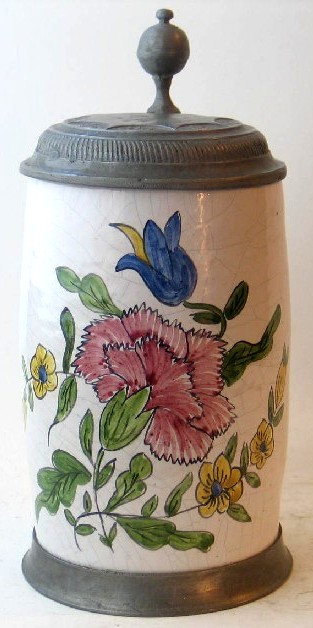
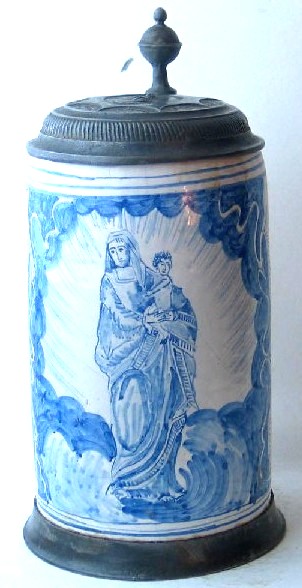 Weygang, fayence steins – The Weygang firm also made a line of fayence steins that were meant to replicate older German ones. They were made Circa 1900 – 1920. Shown: Two examples; the one just above is very similar to an older Nurnberg stein showing Mary and Jesus. Collector’s hint: the thumblifts and lids are most always the same one; their lids have a large star/ sun pattern in relief. See: http://www.steinmarks.co.uk/pages/pv.asp?p=stein1 White Metal — An alloy usually containing two or more of the following elements: tin, copper, lead, antimony and bismuth. The color depends on whether lead or tin predominates. The more tin the whiter the color. Spelter is the common name associated with this alloy . Commonly miscalled as pewter White-smith- A seldom used term now a-days. It refers to ny metal-smith that does not work in iron or steel (The blacksmiths) Mostly used to refer to tin-smiths as it is about the brightest shinny metal.
Weygang, fayence steins – The Weygang firm also made a line of fayence steins that were meant to replicate older German ones. They were made Circa 1900 – 1920. Shown: Two examples; the one just above is very similar to an older Nurnberg stein showing Mary and Jesus. Collector’s hint: the thumblifts and lids are most always the same one; their lids have a large star/ sun pattern in relief. See: http://www.steinmarks.co.uk/pages/pv.asp?p=stein1 White Metal — An alloy usually containing two or more of the following elements: tin, copper, lead, antimony and bismuth. The color depends on whether lead or tin predominates. The more tin the whiter the color. Spelter is the common name associated with this alloy . Commonly miscalled as pewter White-smith- A seldom used term now a-days. It refers to ny metal-smith that does not work in iron or steel (The blacksmiths) Mostly used to refer to tin-smiths as it is about the brightest shinny metal. 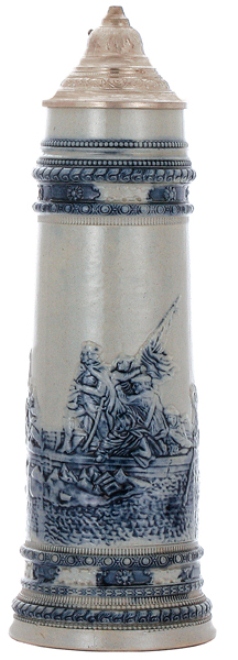 Whites, of Utica, N.Y. (One “T”) – Stoneware potters / stein manufacturers that came over from Germany and established a kiln at Utica. Their steins can be distinguished from the older German Westerwald versions by the bright glaze and by the two large side scenes, with the seam facing towards the viewer. They have larger / thinner than usual numerals depicting the mold size only, and not the designs as done with most other stein maker firms! Shown top: A White’s showing General Washington crossing the Delaware River, and not the Potomac River as one historically challenged eBay seller recently quoted! [TSACO] Also see web page: http://www.steinmarks.co.uk/pages/pv.asp?p=stein1 Also See article: http://www.beerstein.net/articles/bsj-5d.htm Below: More examples of White’s of Utica wares.
Whites, of Utica, N.Y. (One “T”) – Stoneware potters / stein manufacturers that came over from Germany and established a kiln at Utica. Their steins can be distinguished from the older German Westerwald versions by the bright glaze and by the two large side scenes, with the seam facing towards the viewer. They have larger / thinner than usual numerals depicting the mold size only, and not the designs as done with most other stein maker firms! Shown top: A White’s showing General Washington crossing the Delaware River, and not the Potomac River as one historically challenged eBay seller recently quoted! [TSACO] Also see web page: http://www.steinmarks.co.uk/pages/pv.asp?p=stein1 Also See article: http://www.beerstein.net/articles/bsj-5d.htm Below: More examples of White’s of Utica wares. 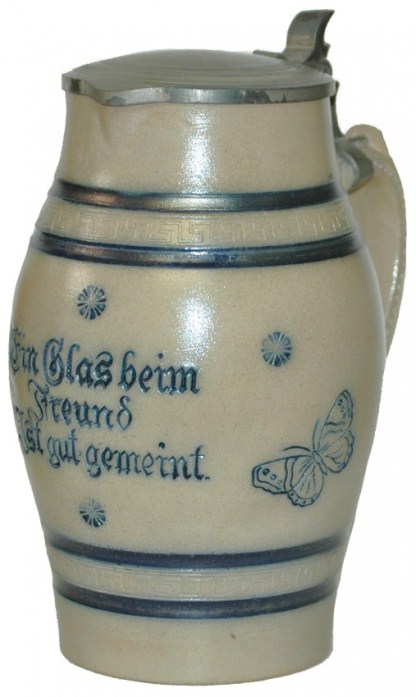 . .
. .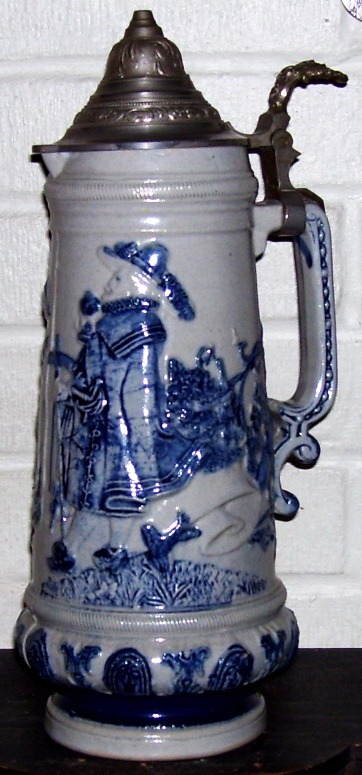 .
. 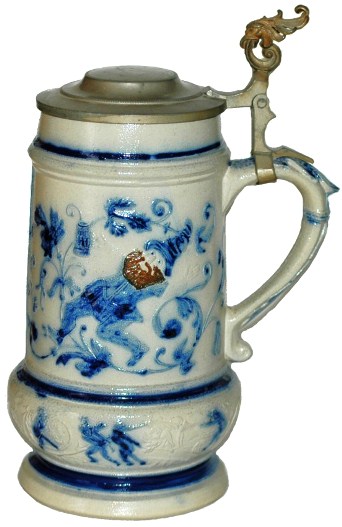 An individual’s stein with a German Heinzelmanchen. ▼ beer server – 1890-1907 . Features a bearded “Man-in-the-Mountains” smoking a cigar and drinking and the other side shows an oriental man near a pagoda smoking and drinking. 10 inches tall.
An individual’s stein with a German Heinzelmanchen. ▼ beer server – 1890-1907 . Features a bearded “Man-in-the-Mountains” smoking a cigar and drinking and the other side shows an oriental man near a pagoda smoking and drinking. 10 inches tall.  .
.  .
.  Base detail of above. .
Base detail of above. . 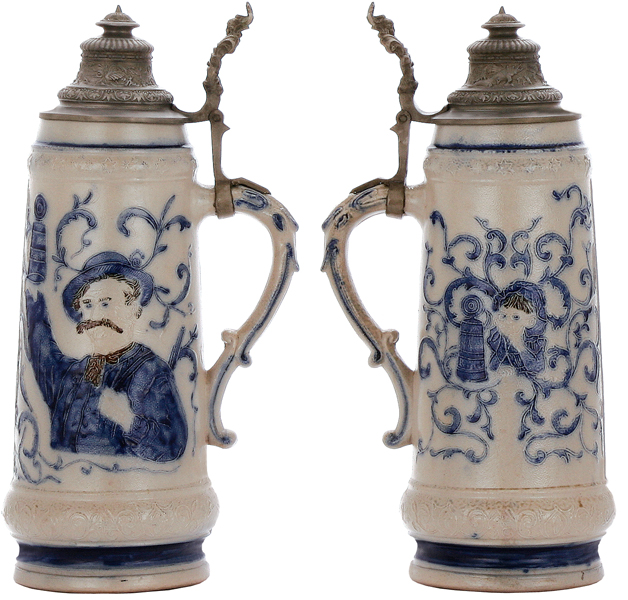 WHITE’S, 2.5L, so called , by US auctioneers “threading” (or “reversed etched” – whatever the hell that means seeing as steins are not etched to begin with!) Made by Whites, Utica, New York. Marked 8, blue & brown glazes. [TSACO]
WHITE’S, 2.5L, so called , by US auctioneers “threading” (or “reversed etched” – whatever the hell that means seeing as steins are not etched to begin with!) Made by Whites, Utica, New York. Marked 8, blue & brown glazes. [TSACO]
Whites of Utica “Bismark” Character Stein. [END – SOK – 57 – R5] ANY COMMENTS? CONTACT ME ? =  “A bus station is where a bus stops. A train station is where a train stops. On my desk and PC, I have a work station!”
“A bus station is where a bus stops. A train station is where a train stops. On my desk and PC, I have a work station!”


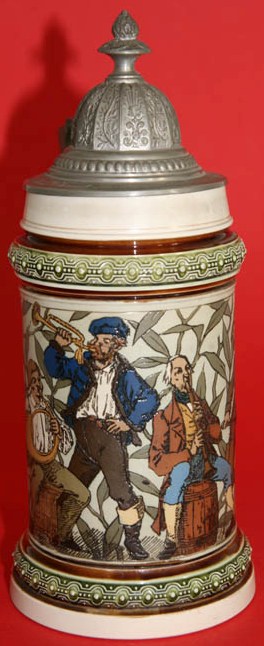
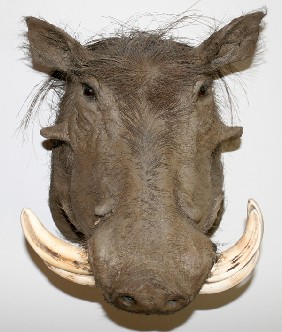

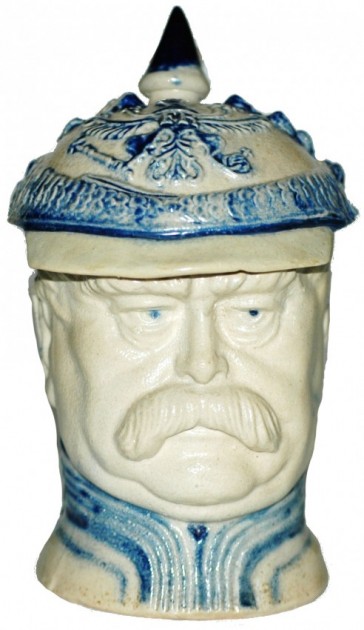
Leave a Reply